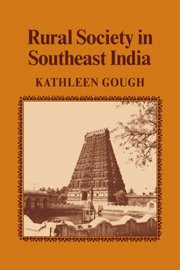Book contents
- Frontmatter
- Contents
- Preface
- Part I Thanjāvūr
- Part II Kumbapeṭṭai
- 8 The Face of the Village
- 9 Kumbapeṭṭai before 1855
- 10 Kumbapeṭṭai from 1855 to 1952
- 11 The Annual Round
- 12 Economics and Class Structure: The Petty Bourgeoisie
- 13 Independent Commodity Producers and Traders
- 14 The Semiproletariat
- 15 Village Politics: Religion, Caste, and Class
- 16 Village Politics: The Street Assembly
- 17 Class Struggle and Village Power Structure
- Part III Kirippūr
- Notes
- Glossary
- Bibliography
- Index
- CAMBRIDGE STUDIES IN SOCIAL ANTHROPOLOGY
13 - Independent Commodity Producers and Traders
from Part II - Kumbapeṭṭai
Published online by Cambridge University Press: 29 October 2009
- Frontmatter
- Contents
- Preface
- Part I Thanjāvūr
- Part II Kumbapeṭṭai
- 8 The Face of the Village
- 9 Kumbapeṭṭai before 1855
- 10 Kumbapeṭṭai from 1855 to 1952
- 11 The Annual Round
- 12 Economics and Class Structure: The Petty Bourgeoisie
- 13 Independent Commodity Producers and Traders
- 14 The Semiproletariat
- 15 Village Politics: Religion, Caste, and Class
- 16 Village Politics: The Street Assembly
- 17 Class Struggle and Village Power Structure
- Part III Kirippūr
- Notes
- Glossary
- Bibliography
- Index
- CAMBRIDGE STUDIES IN SOCIAL ANTHROPOLOGY
Summary
The class of independent commodity producers and traders was only slightly more prosperous than the semiproletariat and was hard to separate from it. Included in this class are individuals and families who owned some capital goods in addition to the tools of their trade and who ran small businesses using mainly the labor of their immediate family or relatives. The owners themselves were also workers, or had been workers until they reached old age. In 1952 this class comprised five households of owner cultivators, or middle peasants, three of paddy traders, two of grocery shopkeepers, three Poosari households that made regalia for temple festivals and ran tea shops, the Brahman restaurant owner, and the Telugu Brahman priest for Non-Brahman life-crisis rites. All except two of these families were Non-Brahmans. Altogether there were fifteen men and sixteen women in this group.
The Middle Peasants
The middle peasants owned from two to five acres of land including wet paddy lands or coconut gardens. They comprised three Kōnār families who had formerly earned money through the paddy trade between Thanjāvūr and Pudukkottai, and two Tamil Nāyakkar brothers who had formerly owned toddy shops and who probably still carried on a little illicit trade in liquor. The Kōnārs came from families who had once been slaves of the Brahmans and had maintained close relations with them, leasing in an average of 7.3 acres of additional land per household from the Brahmans on kuthakai.
- Type
- Chapter
- Information
- Rural Society in Southeast India , pp. 253 - 259Publisher: Cambridge University PressPrint publication year: 1982



